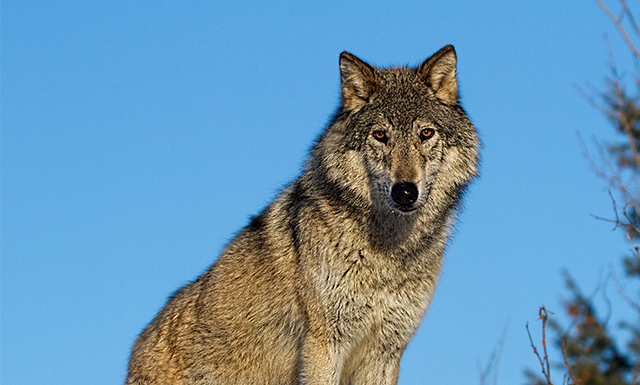Predator Coexistence - United States
Coexistence is a better existence for allwhy delisting gray wolves from the Endangered Species Act would spell trouble for the species—and our shared ecosystems
why delisting gray wolves from the Endangered Species Act would spell trouble for the species—and our shared ecosystems

Gray wolves, one of the North America’s most iconic animals, were once found throughout much of the continent. As a keystone species, they helped maintain a balanced and healthy ecosystem by keeping deer and other herbivore populations at healthy levels. By the 1930s, however, wolves had been hunted and trapped into virtual extinction in the U.S. Indeed, the gray wolf was among the first species to receive Endangered Species Act (ESA) protections after the Act became law in 1973.
Because wolves are so important to the landscape, the government took the extraordinary step of reintroducing several packs into Yellowstone National Park in 1995. Ever since this iconic moment in conservation history, scientists and land managers have seen the park’s ecosystem transform. Sedentary elk populations moved away from the riverside allowing vegetation to regrow and overgrazed aspen to regenerate. Beavers then moved back into healthy streams and waterways while bird populations increased. None of this would have been possible without the wolves and their critical role in the ecosystem.
However, not everyone was happy to see gray wolves return to their rightful place in the American ecosystem. Farmers and ranchers worried that wolves would prey on livestock, and some hunters feared overly-abundant deer and elk populations would be reduced. Even as gray wolves struggled to regain a fragile toe-hold in their native lands, these groups began agitating for looser restrictions aimed at removing them. The result has been a decades-spanning controversy with gray wolves repeatedly losing and gaining protection over the years.
Today, about 6,000 wolves populate the U.S. in less than 20 percent of their historical range; however, a new twist could make life even harder for the U.S.’s embattled gray wolf populations. Last week, the U.S. Fish and Wildlife Service (FWS) officially proposed to remove the remaining ESA protections for gray wolves that reside in the lower 48 states, essentially declaring them recovered.
When a species is deemed “recovered” and removed from the endangered species list, it can be a cause for celebration. Think of the bald eagle, or American alligator, or most humpback whale populations; all of which have recovered from near extinction thanks to ESA protections and other laws, regulations, and continued protections.
However, we and many other scientists and conservationists are not celebrating the proposed delisting of the gray wolf. Without ESA protection, wolves would be at the mercy of states which have repeatedly demonstrated they will immediately turn to aggressive hunting and trapping quotas, all in the name of protecting livestock and increasing populations of deer as well as other game species to create more hunting opportunities of artificially overpopulated species. In fact, in 2014, Montana, Idaho, and Wyoming allowed 642 wolves to be killed either through hunting or by tax funded government killing when there were only an estimated 1,592 wolves in the aforementioned states at the beginning of the year.
Wolves do occasionally prey on sheep and cattle but losses to wolves still remains a tiny proportion of overall livestock losses. In 2014, wolves reportedly killed .002 percent and .01 percent of the cattle and sheep, respectively, which live in Montana, Idaho, and Wyoming.
We should be focusing on ways to coexist with wolves so people, animals, and the ecosystem can all thrive together. Attempting to suppress their population through sweeping open seasons, bounties, or tax funded killing to protect livestock and artificially inflate game populations is the exact same thinking that nearly drove gray wolves into extinction and will land them right back on the endangered species list.
Our lands evolved with wolves and we need them present and abundant to have a healthy environment. Millions of hikers, bikers, hunters, anglers, bird watchers, and more enjoy these landscapes every year, bringing business to rural communities across the country. Wolves are a huge part of that story, both as a cultural touchstone and as an irreplaceable part of a balanced ecosystem.
We call on the U.S. Fish and Wildlife Service to keep Endangered Species Act protections in place for the gray wolf. Too much is at stake – for the ecosystem, for the current balance that exists, and for future biodiversity – to allow states to manage a species they have clearly unilaterally decided is a nuisance to be killed at will.
Related content
every problem has a solution, every solution needs support.
The problems we face are urgent, complicated, and resistant to change. Real solutions demand creativity, hard work, and involvement from people like you.